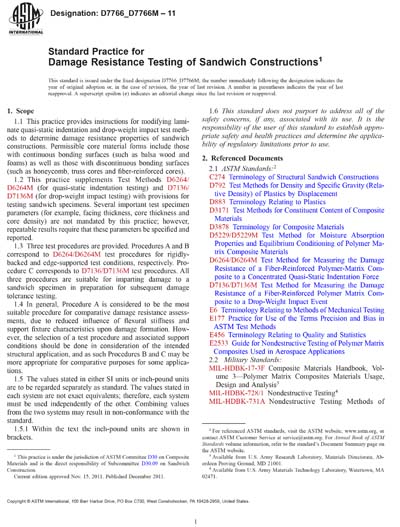Historical
ASTM D7766/D7766M-11
Standard Practice for Damage Resistance Testing of Sandwich Constructions
1.1 This practice provides instructions for modifying laminate quasi-static indentation and drop-weight impact test methods to determine damage resistance properties of sandwich constructions. Permissible core material forms include those with continuous bonding surfaces (such as balsa wood and foams) as well as those with discontinuous bonding surfaces (such as honeycomb, truss cores and fiber-reinforced cores).
1.2 This practice supplements Test Methods D6264/D6264M (for quasi-static indentation testing) and D7136/D7136M (for drop-weight impact testing) with provisions for testing sandwich specimens. Several important test specimen parameters (for example, facing thickness, core thickness and core density) are not mandated by this practice; however, repeatable results require that these parameters be specified and reported.
1.3 Three test procedures are provided. Procedures A and B correspond to D6264/D6264M test procedures for rigidlybacked and edge-supported test conditions, respectively. Procedure C corresponds to D7136/D7136M test procedures. All three procedures are suitable for imparting damage to a sandwich specimen in preparation for subsequent damage tolerance testing.
1.4 In general, Procedure A is considered to be the most suitable procedure for comparative damage resistance assessments, due to reduced influence of flexural stiffness and support fixture characteristics upon damage formation. However, the selection of a test procedure and associated support conditions should be done in consideration of the intended structural application, and as such Procedures B and C may be more appropriate for comparative purposes for some applications.
1.5 The values stated in either SI units or inch-pound units are to be regarded separately as standard. The values stated in each system are not exact equivalents; therefore, each system must be used independently of the other. Combining values from the two systems may result in non-conformance with the standard.
1.5.1 Within the text the inch-pound units are shown in brackets.
1.6 This standard does not purport to address all of the safety concerns, if any, associated with its use. It is the responsibility of the user of this standard to establish appropriate safety and health practices and determine the applicability of regulatory limitations prior to use.
ASTM International [astm]

